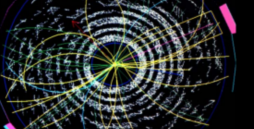Speaker
Mr
Nitish Nayak
(University of California-Irvine)
Description
NOvA is a long-baseline neutrino oscillation experiment that is designed to probe the neutrino mass hierarchy and mixing structure. It uses two functionally identical liquid scintillator detectors 14mrad off-axis from the NuMI beamline at Fermilab, allowing a tightly focused neutrino flux peaked at around 2 GeV. The Near Detector is located 100 m underground and is used to characterize the neutrino beam before oscillations. Since the beam components are affected differently by oscillations, the data collected at the Near Detector needs to be broken down into these components. This enables a precise prediction to be made of the beam-induced backgrounds to the $\nu_{e}$ appearance signal at the Far Detector, 810 km from the neutrino source. Various data-driven techniques are employed for this purpose, in particular by constraining the flux yields and correcting for observed neutrino interaction characteristics. In this talk, I will present an overview of the methodology used to decompose the Near Detector data and predict the FD spectrum in the latest $\nu_{e}$ appearance analysis, utilizing an accumulated exposure of $6.05\times10^{20}$ protons-on-target.
Primary author
Mr
Nitish Nayak
(University of California-Irvine)
